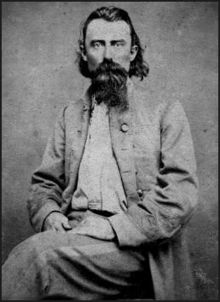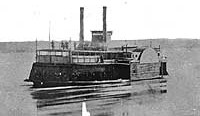Joseph O. Shelby facts for kids
Quick facts for kids
Joseph O. Shelby
|
|
|---|---|

Shelby in uniform
|
|
| Birth name | Joseph Orville Shelby |
| Born | December 12, 1830 Lexington, Kentucky, U.S. |
| Died | February 13, 1897 (aged 66) Bates County, Missouri, U.S. |
| Buried |
Forest Hill Cemetery,
(39°00′07.0″N 94°34′12.8″W / 39.001944°N 94.570222°W)Kansas City, Missouri, U.S. |
| Allegiance | |
| Service/ |
|
| Years of service |
|
| Rank | Brigadier-General (CSA) |
| Commands held | Shelby's Brigade |
| Battles/wars | American Civil War |
| Spouse(s) | Elizabeth Nancy Shelby |
Joseph Orville "J.O." Shelby (born December 12, 1830 – died February 13, 1897) was an important officer in the Confederate States Army. He led cavalry (soldiers on horseback) during the American Civil War in the western parts of the United States, known as the Trans-Mississippi Theater.
Contents
Joseph Shelby's Early Life & Business
Joseph Orville Shelby was born in Lexington, Kentucky. His family was one of the richest and most powerful in the state. He lost his father when he was five years old. His stepfather, Benjamin Gratz, raised him.
Shelby went to Transylvania University. Until 1852, he worked as a rope maker. Later, he moved to Waverly, Missouri. There, he became involved in steamboating on the Missouri River. He also managed a hemp plantation, a rope factory, and a sawmill. These businesses helped Shelby become one of the wealthiest people in Missouri.
Shelby's Role in Bleeding Kansas
In 1854, the Kansas–Nebraska Act was passed. This law allowed people in new territories to decide if they wanted slavery. Many people from New England who were against slavery moved to Kansas. In response, a group called the Blue Lodge was formed by important Missourians. This group wanted Kansas to become a slave state. Joseph O. Shelby was a key member of this group.
Shelby first got involved in Kansas during an election on March 30, 1855. This election was for the Kansas territory's government. Many Missourians who did not live in Kansas voted illegally. They sometimes scared election officials to prevent them from checking who was allowed to vote. Shelby and other Missourians also bothered people who were against slavery trying to vote.
Shelby's involvement in the border disputes between Missouri and Kansas hurt his businesses. In December 1855, his new sawmill burned down. It seemed like someone had set it on fire on purpose. The mill was not insured, and the loss was over $9,000. Shelby eventually sold his business in 1860.
Joseph Shelby in the Civil War
When the Civil War began in April 1861, Missouri's governor refused to send soldiers to the Union. This led to fighting between state and federal groups. The pro-secession Missouri State Guard was created.
Shelby formed a group called the Lafayette County Mounted Rifles. He was chosen as their captain. He led his company in battles like Carthage, Wilson's Creek, and Pea Ridge.
Shelby's Promotion & Iron Brigade
In 1862, Shelby was promoted to colonel. He was allowed to recruit a Confederate cavalry regiment. He went back to Lafayette County to gather soldiers. After safely bringing his new regiment to Arkansas, he was given command of a brigade of new regiments.
In the fall of 1863, Shelby led his "Iron Brigade" on a long cavalry raid. This was one of the longest raids of the war at that time. From September 22 to November 3, 1863, Shelby's brigade rode 1,500 miles through Missouri. They caused over 1,000 casualties to Union forces. They also captured or destroyed about $2 million worth of Union supplies and property. Because of this successful raid, Shelby was promoted to brigadier-general on December 15, 1863.
Later Battles & Promotions
In 1864, Union General Frederick Steele's plan failed during the Camden Expedition. This was largely because Shelby and other Confederate forces constantly bothered Steele's men. Steele's soldiers had to retreat to Little Rock. This happened after their supply trains were destroyed or captured at the Battle of Marks' Mills.
Shelby was then sent to Clarendon, Arkansas. There, he managed to capture a Union gunboat called the USS Queen City. This boat was lightly armored. Shelby's men burned the gunboat to stop the Union from getting it back.
Shelby later commanded a division during Price's Missouri Expedition. He fought well at the battles of Little Blue River and Westport. He also briefly captured many towns from Union control. These towns included Potosi, Boonville, Waverly, Stockton, Lexington, and California, Missouri.
After the main Confederate army surrendered in April 1865, General Edmund Kirby Smith promoted Shelby to major general on May 10. However, this promotion was never officially recognized because the Confederate government collapsed.
Shelby's Later Years
In June 1865, Joseph Shelby and about 1,000 of his soldiers refused to surrender. Instead, they rode south into Mexico. It is said that Shelby sank his battle flag in the Rio Grande river. This was near Eagle Pass, Texas, so the flag would not fall into Union hands. A painting at the Eagle Pass City Hall shows this event. Because they refused to surrender, Shelby's men became known as "the undefeated."
A poem about them says:
I won't be reconstructed, I'm better now than then.
And for a Carpetbagger I do not care.
So it's forward to the frontier, soon as I can go.
I'll fix me up a weapon and start for Mexico.
Shelby and his men planned to offer their services to Emperor Maximilian of Mexico. Maximilian did not accept them into his army. However, he did give them land for a settlement called the New Virginia Colony. This American settlement was in Mexico near Veracruz. Two years later, the empire fell apart, and Maximilian was executed. The land grant was taken back. The story of Shelby and his "Undefeated" men inspired a 1969 John Wayne and Rock Hudson movie called The Undefeated.
Shelby returned to Missouri in 1867 and went back to farming. In 1883, Shelby was an important witness for Frank James, another former Confederate. In 1893, Shelby was appointed the U.S. Marshal for western Missouri. He held this job until he died. He appointed an African American person to an office, which caused some disagreement among his neighbors. Shelby defended his decision.
Shelby died from pneumonia at his farm near Adrian, Missouri in 1897. He is buried in Kansas City.
Personal Life
On July 22, 1857, Shelby married Elizabeth Nancy Shelby. She was his first cousin's daughter and much younger than him. They had a big wedding on a steamboat and honeymooned in St. Louis. She was known as Betty or Betsy.



